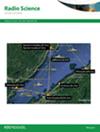利用基于电磁时间反转的方法探测地雷:2. TR-MUSIC 的性能分析
IF 1.6
4区 地球科学
Q3 ASTRONOMY & ASTROPHYSICS
引用次数: 0
摘要
本文针对各种二维和三维配置进行了一系列数值模拟,以证明时间反转多重信号分类(TR-MUSIC)方法的性能。结果表明,考虑到噪声、土壤类型(均质土壤和层状土壤)及其电参数以及不同类型目标(数量、大小、形状和位置各不相同)的影响,TR-MUSIC 具有卓越的性能。此外,与其他基于 TR 的电磁技术不同,TR-MUSIC 具有极高的分辨率(1/10 或更高),传感器数量合理,可探测多个紧密间隔的目标。在基于 TR 的方法中,来自物体或地雷的反射至关重要,并由地雷及其周围介质的构成参数(如介电常数、渗透率和电导率)之间的差异决定。因此,与传统的基于 GPR 的方法类似,基于 TR 的方法适用于探测构成参数与其浸入介质相比存在显著差异的物体或地雷。本研究主要侧重于金属物体或地雷。本文章由计算机程序翻译,如有差异,请以英文原文为准。
Landmine detection using electromagnetic time reversal-based methods: 2. performance analysis of TR-MUSIC
In this paper, a series of numerical simulations are conducted for various 2D and 3D configurations to demonstrate the performance of the Time Reversal Multiple Signal Classification (TR-MUSIC) method. The results reveal the excellent performance of TR-MUSIC, taking into account the effects of noise, soil types (both homogeneous and layered), and their electrical parameters, as well as different types of targets (varying in number, size, shape, and location). Additionally, unlike other electromagnetic TR-based techniques, TR-MUSIC offers very high resolution (on the order of 1/10 or higher) with a reasonable number of sensors, enabling the detection of multiple closely spaced targets. In TR-based methods, reflections from the object(s) or landmine(s) are crucial and are determined by the difference between the constitutive parameters (e.g., permittivity, permeability, and conductivity) of the landmine(s) and their surrounding medium. Therefore, TR-based approaches, similar to conventional GPR-based approaches, are suitable for detecting objects or landmines with significant differences in constitutive parameters compared to their immersion medium. This research primarily focuses on metallic objects or landmines.
求助全文
通过发布文献求助,成功后即可免费获取论文全文。
去求助
来源期刊

Radio Science
工程技术-地球化学与地球物理
CiteScore
3.30
自引率
12.50%
发文量
112
审稿时长
1 months
期刊介绍:
Radio Science (RDS) publishes original scientific contributions on radio-frequency electromagnetic-propagation and its applications. Contributions covering measurement, modelling, prediction and forecasting techniques pertinent to fields and waves - including antennas, signals and systems, the terrestrial and space environment and radio propagation problems in radio astronomy - are welcome. Contributions may address propagation through, interaction with, and remote sensing of structures, geophysical media, plasmas, and materials, as well as the application of radio frequency electromagnetic techniques to remote sensing of the Earth and other bodies in the solar system.
 求助内容:
求助内容: 应助结果提醒方式:
应助结果提醒方式:


